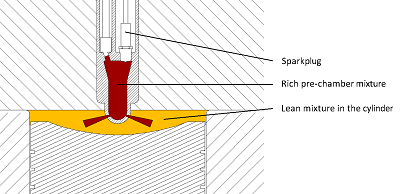
Spark ignited
Both Rolls Royce and Wärtsilä have developed spark ignited gas engines utilizing basically the same principle. Gas is mixed with air before the inlet valves and fed to the cylinder. A portion of the mixture with higher gas concentration is fed to a pre chamber where a spark initiates the combustion at the end of compression. The flame from the pre chamber in turn ignites the fuel mixture in the cylinder. The advantage with the spark plug route is that no other fuel is needed to initiate the combustion but it also limit the flexibility as dual fuel operation is not supported.
Compared to a duel fuel engine the compression ratio is lower to prevent knocking concern regardless of load and power transients. Combustion temperatures are kept low with a lean fuel/air mixture and emissions are comparatively low. The current engines are pure gas engines but conversion to methanol should be possible. Rolls Royce claim that their gas engine relying on spark plugs achieve higher efficiency and better load response compared to use of pilot diesel to initiate the combustion.

Figure 11: Principal sketch of a spark ignited gas engine. The spark plug ignites the rich fuel mixture in the pre-chamber that in turn ignites the leaner fuel mixture in the cylinder.
As the spark plug is located in a pre chamber it is partially protected from the high pressure in the cylinder. This allows spark plugs to be used in high compression engines with good enough reliability.